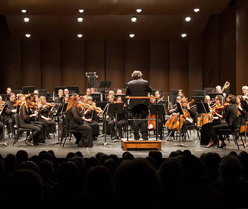Music » Symphonic » Spirituelle Arménie » Symphony

Komitas | Petros Shoujounian, Polyphonic Suite for orchestra inspired by the spiritual legacy of Komitas
To write his Polyphonic Suite for Orchestra, Shoujounian drew from Komitas’ Divine Liturgy (or Patarag in Armenian), which itself is rooted in Armenian Orthodox ritual. To underscore the richness of the liturgical music of the Armenian Apostolic Church, while at the same time drawing on his considerable knowledge of Western European music and Renaissance vocal polyphony, Komitas boldly transformed traditional Orthodox music into complex polyphony. The result is a powerful and meditative work. Shoujounian adapted this magnificent vocal work for orchestra, further enriching its palette of sounds and colours.
With all deference as a great admirer of Komitas, Shoujounian is confident that the composer would have wished to, or eventually would have, written for orchestra (most of his works are vocal pieces or pieces for small ensemble) if his creative impetus had not been tragically disrupted by the Armenian genocide of 1915. Deported, detained, then miraculously released, Komitas never recovered from this traumatic, life-obliterating event. Confined to a psychiatric hospital from 1916 until his death in 1935, this champion of Armenian culture in many ways embodies the sufferings of his people, who faced the same horrors. Thus, it is in a spirit of tribute to Komitas and all that he represents, that Shoujounian composed the two works for orchestra that are featured on this programme.
Komitas | Petros Shoujounian, Suite polyphonique pour orchestre inspirée de l’héritage spirituel de Komitas
Traçant un trait d’union entre le passé et le présent, Petros Shoujounian prend comme point de départ deux œuvres de Komitas – soit Sept danses pour piano et la Divine Liturgie – qu’il modifie et adapte librement pour orchestre symphonique.
Dans la lignée du vent nationaliste qui souffle sur les pays de l’Est à l’orée du 20e siècle, Komitas cherche à traduire l’essence de la musique arménienne dans sa musique. Datant de 1911, les Sept danses, courtes pièces pour piano solo, correspondent à cette quête. Ici transformées en un concerto pour piano et orchestre, elles évoquent dans leur version originale les timbres caractéristiques des instruments traditionnels arméniens en plus d’illustrer quelques particularités du style de Komitas telles que la polyrythmie, l’utilisation des modes, les rythmes irréguliers et les accords en quarte et en quinte. Tentant, un peu à la manière de Bartók, de créer un nouveau langage à travers le folklore de son pays, Komitas est reconnu par plusieurs compositeurs occidentaux de son époque, particulièrement en France où Vincent d’Indy, Fauré, Saint-Saëns, Ravel et Debussy admirent le travail de ce « père du renouveau de la musique arménienne ».
VIDEOS ARCHIVE

I.Le mystère-Le roi-L'élu-L'intercession visuel
Request access

II.Louange-Le ressucité-Réconciliation-Saint!Saint!Saint! visuel
Request access

III.Lapaix-Notre Père-La trinité-Pitiés visuel
Request access

IV.Bénédiction-Gratification-Ainsi soit-il visual
Request access

 Click here to view the photo gallery.
Click here to view the photo gallery.